Assessing the Influence of Urine pH on the Efficacy of Ciprofloxacin and Fosfomycin in Immunocompetent and Immunocompromised Murine Models of Escherichia coli and Klebsiella pneumoniae Infection in the Lower Urinary Tract
Abstract
:1. Introduction
2. Results
2.1. In Vitro Assays
2.1.1. Time–Kill Curve Assays
2.1.2. Pharmacodynamics of Ciprofloxacin and Fosfomycin
2.2. In Vivo Assays
2.2.1. Impact of Acidic Urine pH and Immunocompromise on the Bacterial Concentrations in the Kidneys in a Lower UTI Model of E. coli
2.2.2. Efficacy of Ciprofloxacin and Fosfomycin in an Immunocompetent Lower UTI Model of E. coli
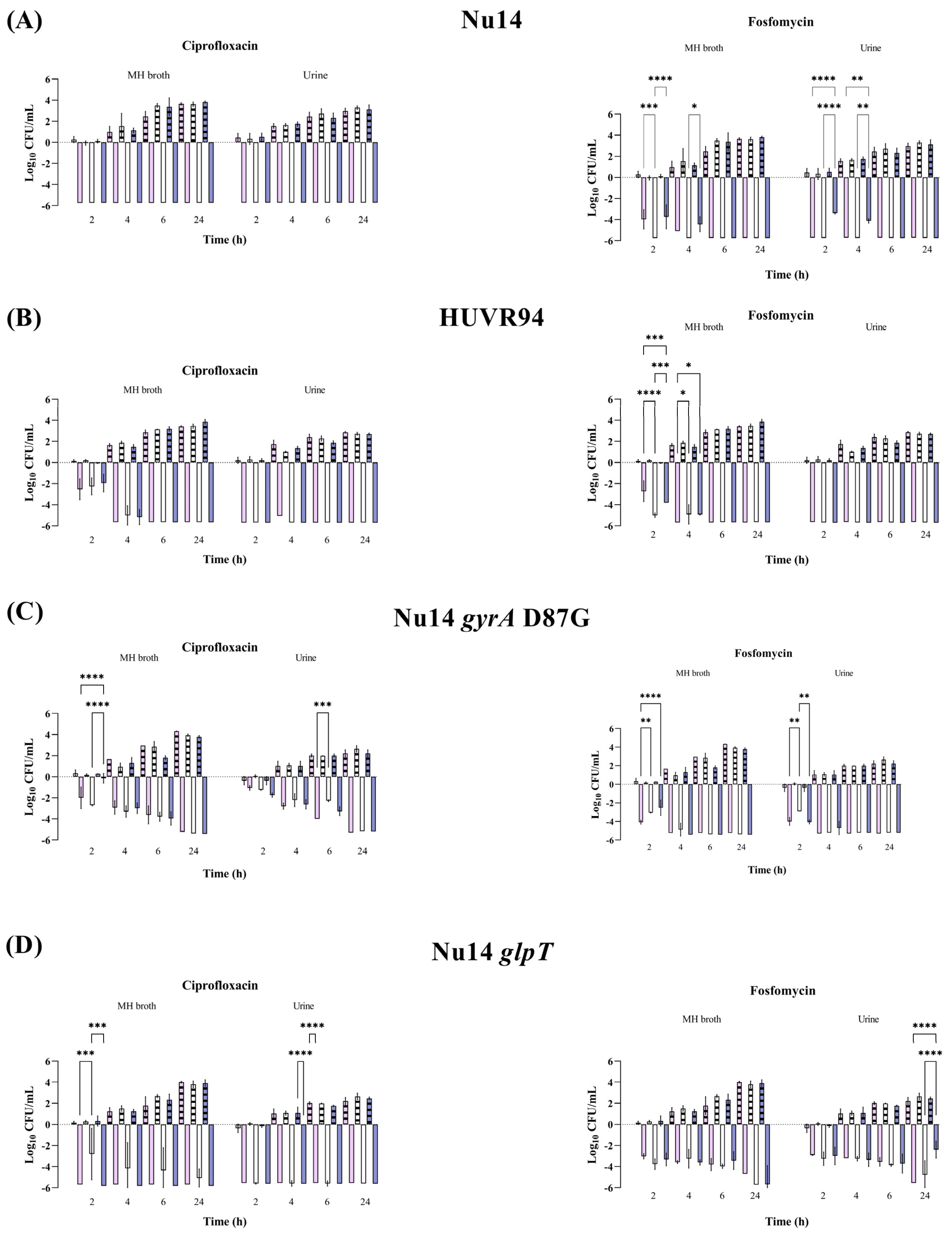
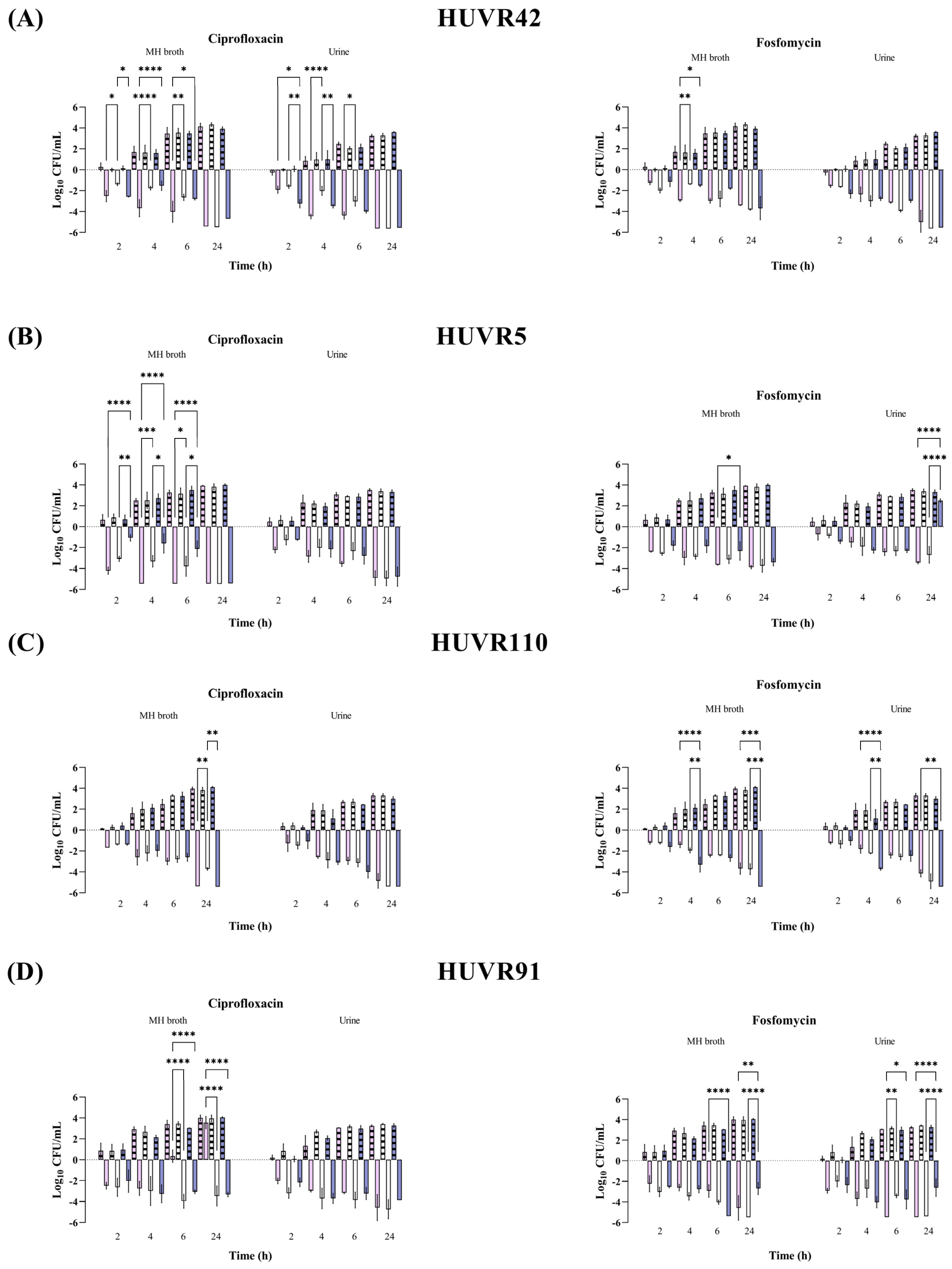
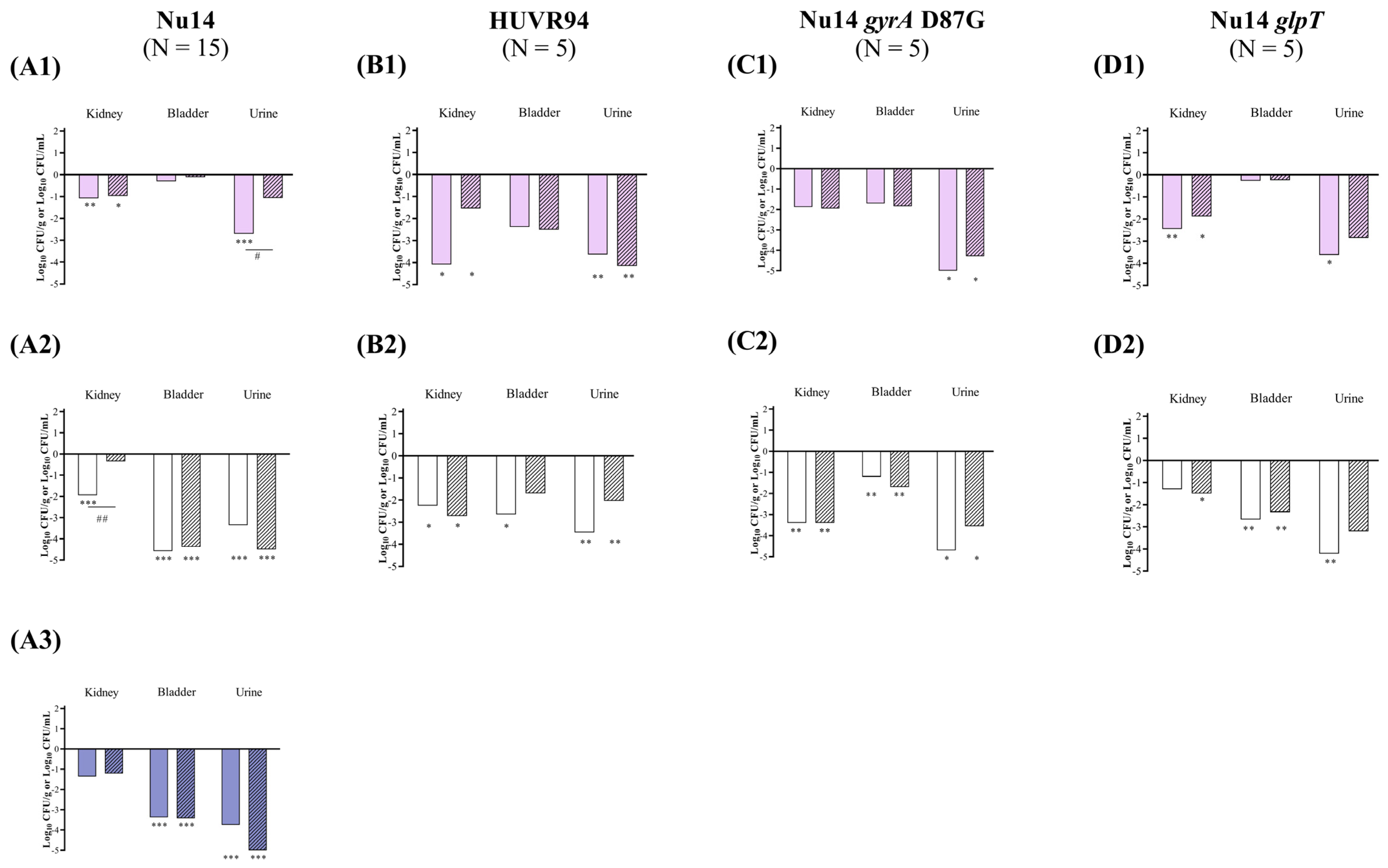
2.2.3. Efficacy of Ciprofloxacin and Fosfomycin in an Immunocompromised Lower UTI Model of E. coli
2.2.4. Impact of Acidic Urine pH and Immunocompromise on the Bacterial Concentrations in the Kidneys in a Lower UTI Model of K. pneumoniae
2.2.5. Efficacy of Ciprofloxacin and Fosfomycin in an Immunocompetent Lower UTI Model of K. pneumoniae
2.2.6. Efficacy of Ciprofloxacin and Fosfomycin in an Immunocompromised Lower UTI Model of K. pneumoniae
3. Discussion
4. Materials and Methods
4.1. Bacterial Strains
4.2. Time–Kill Curve Assays
4.3. In Vivo Assays
4.3.1. Animals
4.3.2. Efficacy of Ciprofloxacin and Fosfomycin Therapy in a Lower UTI Model with Different Urine pH in Immunocompetent and Immunocompromised Mice
4.4. Statistical Analysis
5. Conclusions
Supplementary Materials
Author Contributions
Funding
Institutional Review Board Statement
Informed Consent Statement
Data Availability Statement
Acknowledgments
Conflicts of Interest
References
- Vidal, E.; Torre-Cisneros, J.; Blanes, M.; Montejo, M.; Cervera, C.; Aguado, J.M.; Len, O.; Carratalá, J.; Cordero, E.; Bou, G.; et al. Bacterial urinary tract infection after solid organ transplantation in the RESITRA cohort. Transpl. Infect. Dis. 2012, 14, 595–603. [Google Scholar] [CrossRef] [PubMed]
- Plate, A.; Kronenberg, A.; Risch, M.; Mueller, Y.; Di Gangi, S.; Rosemann, T.; Senn, O. Active surveillance of antibiotic resistance patterns in urinary tract infections in primary care in Switzerland. Infection 2019, 47, 1027–1035. [Google Scholar] [CrossRef] [PubMed]
- Tekkarışmaz, N.; Özelsancak, R.; Micozkadıoğlu, H.; Çalışkan, K.; Demiroğlu, Y.Z.; Arslan, A.H.; Haberal, M. Risk Factors for Urinary Tract Infection After Kidney Transplant: A Retrospective Analysis. Exp. Clin. Transplant. 2020, 18, 306–312. [Google Scholar] [CrossRef] [PubMed]
- Valera, B.; Gentil, M.A.; Cabello, V.; Fijo, J.; Cordero, E.; Cisneros, J.M. Epidemiology of urinary infections in renal transplant recipients. Transplant. Proc. 2006, 38, 2414–2415. [Google Scholar] [CrossRef] [PubMed]
- Bodro, M.; Sanclemente, G.; Lipperheide, I.; Allali, M.; Marco, F.; Bosch, J.; Cofan, F.; Ricart, M.J.; Esforzado, N.; Oppenheimer, F.; et al. Impact of urinary tract infections on short-term kidney graft outcome. Clin. Microbiol. Infect. 2015, 21, 1104.e1–1104.e8. [Google Scholar] [CrossRef]
- Kot, B. Antibiotic Resistance Among Uropathogenic Escherichia coli. Pol. J. Microbiol. 2019, 68, 403–415. [Google Scholar] [CrossRef]
- Vila, J.; Sáez-López, E.; Johnson, J.R.; Römling, U.; Dobrindt, U.; Cantón, R.; Giske, C.G.; Naas, T.; Carattoli, A.; Martínez-Medina, M.; et al. Escherichia coli: An old friend with new tidings. FEMS Microbiol. Rev. 2016, 40, 437–463. [Google Scholar] [CrossRef] [PubMed]
- Ny, S.; Edquist, P.; Dumpis, U.; Gröndahl-Yli-Hannuksela, K.; Hermes, J.; Kling, A.M.; Klingeberg, A.; Kozlov, R.; Källman, O.; Lis, D.O.; et al. Antimicrobial resistance of Escherichia coli isolates from outpatient urinary tract infections in women in six European countries including Russia. J. Glob. Antimicrob. Resist. 2019, 17, 25–34. [Google Scholar] [CrossRef] [PubMed]
- King, D.E.; Malone, R.; Lilley, S.H. New classification and update on the quinolone antibiotics. Am. Fam. Physician 2000, 61, 2741–2748. [Google Scholar]
- Suaifan, G.; Mohammed, A.A.M. Fluoroquinolones structural and medicinal developments (2013–2018): Where are we now? Bioorg. Med. Chem. 2019, 27, 3005–3060. [Google Scholar] [CrossRef]
- Drusano, G.L.; Standiford, H.C.; Plaisance, K.; Forrest, A.; Leslie, J.; Caldwell, J. Absolute oral bioavailability of ciprofloxacin. Antimicrob. Agents Chemother. 1986, 30, 444–446. [Google Scholar] [CrossRef]
- Wagenlehner, F.M.; Kinzig-Schippers, M.; Sörgel, F.; Weidner, W.; Naber, K.G. Concentrations in plasma, urinary excretion and bactericidal activity of levofloxacin (500 mg) versus ciprofloxacin (500 mg) in healthy volunteers receiving a single oral dose. Int. J. Antimicrob. Agents 2006, 28, 551–559. [Google Scholar] [CrossRef] [PubMed]
- EMA (European Medicines Agency). Disabling and Potentially Permanent Side Effects Lead to Suspension or Restrictions of Quinolone and Fluoroquinolone Antibiotics. 2018. Available online: https://www.ema.europa.eu/en/documents/referral/quinolone-and-fluoroquinolone-article-31-referral-disabling-and-potentially-permanent-side-effects-lead-suspension-or-restrictions-quinolone-and-fluoroquinolone-antibiotics_en.pdf (accessed on 20 March 2024).
- Zykov, I.N.; Samuelsen, Ø.; Jakobsen, L.; Småbrekke, L.; Andersson, D.I.; Sundsfjord, A.; Frimodt-Møller, N. Pharmacokinetics and Pharmacodynamics of Fosfomycin and Its Activity against Extended-Spectrum-β-Lactamase-, Plasmid-Mediated AmpC-, and Carbapenemase-Producing Escherichia coli in a Murine Urinary Tract Infection Model. Antimicrob. Agents Chemother. 2018, 62. [Google Scholar] [CrossRef]
- Rodríguez-Gascón, A.; Canut-Blasco, A. Deciphering pharmacokinetics and pharmacodynamics of fosfomycin. Rev. Esp. Quimioter. 2019, 32 (Suppl. 1), 19–24. [Google Scholar] [PubMed]
- Cattoir, V.; Pourbaix, A.; Magnan, M.; Chau, F.; de Lastours, V.; Felden, B.; Fantin, B.; Guérin, F. Novel Chromosomal Mutations Responsible for Fosfomycin Resistance in Escherichia coli. Front. Microbiol. 2020, 11, 575031. [Google Scholar] [CrossRef] [PubMed]
- Zurfluh, K.; Treier, A.; Schmitt, K.; Stephan, R. Mobile fosfomycin resistance genes in Enterobacteriaceae-An increasing threat. Microbiol. Open 2020, 9, e1135. [Google Scholar] [CrossRef] [PubMed]
- Raja, N.S. Oral treatment options for patients with urinary tract infections caused by extended spectrum βeta-lactamase (ESBL) producing Enterobacteriaceae. J. Infect. Public. Health 2019, 12, 843–846. [Google Scholar] [CrossRef]
- Rivera-Sanchez, R.; Delgado-Ochoa, D.; Flores-Paz, R.R.; García-Jiménez, E.E.; Espinosa-Hernández, R.; Bazan-Borges, A.A.; Arriaga-Alba, M. Prospective study of urinary tract infection surveillance after kidney transplantation. BMC Infect. Dis. 2010, 10, 245. [Google Scholar] [CrossRef]
- Erdogan-Yildirim, Z.; Burian, A.; Manafi, M.; Zeitlinger, M. Impact of pH on bacterial growth and activity of recent fluoroquinolones in pooled urine. Res. Microbiol. 2011, 162, 249–252. [Google Scholar] [CrossRef]
- Nussbaumer-Pröll, A.K.; Eberl, S.; Reiter, B.; Stimpfl, T.; Dorn, C.; Zeitlinger, M. Low pH reduces the activity of ceftolozane/tazobactam in human urine, but confirms current breakpoints for urinary tract infections. J. Antimicrob. Chemother. 2020, 75, 593–599. [Google Scholar] [CrossRef]
- Giannakopoulos, X.; Evangelou, A.; Kalfakakou, V.; Grammeniatis, E.; Papandropoulos, I.; Charalambopoulos, K. Human bladder urine oxygen content: Implications for urinary tract diseases. Int. Urol. Nephrol. 1997, 29, 393–401. [Google Scholar] [CrossRef]
- Kottur, J.; Nair, D.T. Reactive Oxygen Species Play an Important Role in the Bactericidal Activity of Quinolone Antibiotics. Angew. Chem. Int. Ed. Engl. 2016, 55, 2397–2400. [Google Scholar] [CrossRef]
- Martín-Gutiérrez, G.; Rodríguez-Beltrán, J.; Rodríguez-Martínez, J.M.; Costas, C.; Aznar, J.; Pascual, Á.; Blázquez, J. Urinary Tract Physiological Conditions Promote Ciprofloxacin Resistance in Low-Level-Quinolone-Resistant Escherichia coli. Antimicrob. Agents Chemother. 2016, 60, 4252–4258. [Google Scholar] [CrossRef] [PubMed]
- Martín-Gutiérrez, G.; Docobo-Pérez, F.; Rodriguez-Beltrán, J.; Rodríguez-Martínez, J.M.; Aznar, J.; Pascual, A.; Blázquez, J. Urinary Tract Conditions Affect Fosfomycin Activity against Escherichia coli Strains Harboring Chromosomal Mutations Involved in Fosfomycin Uptake. Antimicrob. Agents Chemother. 2018, 62. [Google Scholar] [CrossRef]
- Herrera-Espejo, S.; Fontserè, S.; Infante, C.; Suárez-Benjumea, A.; Carretero-Ledesma, M.; Suñer-Poblet, M.; González-Corvillo, C.; Bernal, G.; Martín-Gutiérrez, G.; Pérez-Cáceres, J.A.; et al. Acidic Urine pH and Clinical Outcome of Lower Urinary Tract Infection in Kidney Transplant Recipients Treated with Ciprofloxacin and Fosfomycin. Antibiotics 2024, 13, 116. [Google Scholar] [CrossRef] [PubMed]
- Fontserè, S.; Infante-Domínguez, C.; Suárez-Benjumea, A.; Suñer-Poblet, M.; González-Corvillo, C.; Martín-Gutiérrez, G.; Bernal, G.; Pachón, J.; Pachón-Ibáñez, M.E.; Cordero, E. Impact of Treating Asymptomatic Bacteriuria in Kidney Transplant Recipients: A Prospective Cohort Study. Antibiotics 2021, 10, 218. [Google Scholar] [CrossRef] [PubMed]
- Herrera-Espejo, S.; Domínguez-Miranda, J.L.; Rodríguez-Mogollo, J.I.; Pachón, J.; Cordero, E.; Pachón-Ibáñez, M.E. Effects of pH on the Pathogenicity of Escherichia coli and Klebsiella pneumoniae on the Kidney: In Vitro and In Vivo Studies. Int. J. Mol. Sci. 2024, 25, 7925. [Google Scholar] [CrossRef] [PubMed]
- Burian, A.; Erdogan, Z.; Jandrisits, C.; Zeitlinger, M. Impact of pH on activity of trimethoprim, fosfomycin, amikacin, colistin and ertapenem in human urine. Pharmacology 2012, 90, 281–287. [Google Scholar] [CrossRef]
- Völgyi, G.; Vizserálek, G.; Takács-Novák, K.; Avdeef, A.; Tam, K.Y. Predicting the exposure and antibacterial activity of fluoroquinolones based on physicochemical properties. Eur. J. Pharm. Sci. 2012, 47, 21–27. [Google Scholar] [CrossRef]
- Nurchi, V.M.; Crisponi, G.; Lachowicz, J.I.; Zoroddu, M.A.; Peana, M.; Medici, S.; Veclani, D.; Tolazzi, M.; Melchior, A. Fluoroquinolones: A micro-species equilibrium in the protonation of amphoteric compounds. Eur. J. Pharm. Sci. 2016, 93, 380–391. [Google Scholar] [CrossRef]
- So, W.; Crandon, J.L.; Nicolau, D.P. Effects of Urine Matrix and pH on the Potency of Delafloxacin and Ciprofloxacin against Urogenic Escherichia coli and Klebsiella pneumoniae. J. Urol. 2015, 194, 563–570. [Google Scholar] [CrossRef]
- Delcour, A.H. Outer membrane permeability and antibiotic resistance. Biochim. Biophys. Acta 2009, 1794, 808–816. [Google Scholar] [CrossRef]
- Kurabayashi, K.; Tanimoto, K.; Fueki, S.; Tomita, H.; Hirakawa, H. Elevated Expression of GlpT and UhpT via FNR Activation Contributes to Increased Fosfomycin Susceptibility in Escherichia coli under Anaerobic Conditions. Antimicrob. Agents Chemother. 2015, 59, 6352–6360. [Google Scholar] [CrossRef]
- Tran, J.H.; Jacoby, G.A.; Hooper, D.C. Interaction of the plasmid-encoded quinolone resistance protein QnrA with Escherichia coli topoisomerase IV. Antimicrob. Agents Chemother. 2005, 49, 3050–3052. [Google Scholar] [CrossRef]
- Rodríguez-Martínez, J.M.; Pichardo, C.; García, I.; Pachón-Ibañez, M.E.; Docobo-Pérez, F.; Pascual, A.; Pachón, J.; Martínez-Martínez, L. Activity of ciprofloxacin and levofloxacin in experimental pneumonia caused by Klebsiella pneumoniae deficient in porins, expressing active efflux and producing QnrA1. Clin. Microbiol. Infect. 2008, 14, 691–697. [Google Scholar] [CrossRef]
- Hooper, D.C.; Strahilevitz, J. Quinolones. In Mandell, Douglas, Bennett. Principles and Practice of Infectious Diseases, 9th ed.; Bennet, J.E., Dolin, R., Blaser, M.J., Eds.; Elsevier: Philadelphia, PA, USA, 2020; Volume 1, pp. 426–448. Available online: https://fama.us.es/discovery/fulldisplay?docid=alma991012946389704987&context=L&vid=34CBUA_US:VU1&lang=es&search_scope=all_data_not_idus&adaptor=Local%20Search%20Engine (accessed on 16 April 2024).
- Lepak, A.J.; Zhao, M.; VanScoy, B.; Taylor, D.S.; Ellis-Grosse, E.; Ambrose, P.G.; Andes, D.R. In Vivo Pharmacokinetics and Pharmacodynamics of ZTI-01 (Fosfomycin for Injection) in the Neutropenic Murine Thigh Infection Model against Escherichia coli, Klebsiella pneumoniae, and Pseudomonas aeruginosa. Antimicrob. Agents Chemother. 2017, 61. [Google Scholar] [CrossRef]
- Merino-Bohórquez, V.; Docobo-Pérez, F.; Sojo, J.; Morales, I.; Lupión, C.; Martín, D.; Cameán, M.; Hope, W.; Pascual, Á.; Rodríguez-Baño, J. Population pharmacokinetics and pharmacodynamics of fosfomycin in non-critically ill patients with bacteremic urinary infection caused by multidrug-resistant Escherichia coli. Clin. Microbiol. Infect. 2018, 24, 1177–1183. [Google Scholar] [CrossRef]
- Horton, J.M. Urinary tract agents: Nitrofurantoin, fosfomycin and methenamine. In Mandell, Douglas, Bennett. Principles and Practice of Infectious Diseases, 9th ed.; Bennet, J.E., Dolin, R., Blaser, M.J., Eds.; Elsevier: Philadelphia, PA, USA, 2020; Volume 1, pp. 461–465. [Google Scholar]
- Chavan, R.; Naphade, B.; Waykar, B.; Bhagwat, S. Investigations on In Vivo Pharmacokinetic/Pharmacodynamic Determinants of Fosfomycin in Murine Thigh and Kidney Infection Models. Microb. Drug Resist. 2023, 29, 18–27. [Google Scholar] [CrossRef]
- Van, V.T.H.; Liu, Z.S.; Hsieh, Y.J.; Shiu, W.C.; Chen, B.Y.; Ku, Y.W.; Chen, P.W. Therapeutic effects of orally administration of viable and inactivated probiotic strains against murine urinary tract infection. J. Food Drug Anal. 2023, 31, 583–598. [Google Scholar] [CrossRef]
- Rodríguez Sánchez, M.P.; Afanador Rubio, D.C.; Luna, I.M.; García Padilla, P.K.; Contreras Villamizar, K.M.; González González, C.A.; Patiño Trejos, J.A. Impact of Complicated Urinary Tract Infection on Renal Graft Function. Transplant. Proc. 2020, 52, 1173–1177. [Google Scholar] [CrossRef]
- Al Midani, A.; Elands, S.; Collier, S.; Harber, M.; Shendi, A.M. Impact of Urinary Tract Infections in Kidney Transplant Recipients: A 4-Year Single-Center Experience. Transplant. Proc. 2018, 50, 3351–3355. [Google Scholar] [CrossRef] [PubMed]
- EUCAST. The European Committee on Antimicrobial Susceptibility Testing. Breakpoint tables for interpretation of MICs and zone diameters. Version 14.0, 2024. Available online: http://www.eucast.org (accessed on 19 March 2024).
- Mehershahi, K.S.; Chen, S.L. Complete Genome Sequence of the Uropathogenic Escherichia coli Strain NU14. Genome Announc. 2017, 5. [Google Scholar] [CrossRef] [PubMed]
- Komp Lindgren, P.; Marcusson, L.L.; Sandvang, D.; Frimodt-Møller, N.; Hughes, D. Biological cost of single and multiple norfloxacin resistance mutations in Escherichia coli implicated in urinary tract infections. Antimicrob. Agents Chemother. 2005, 49, 2343–2351. [Google Scholar] [CrossRef]
- Nilsson, A.I.; Berg, O.G.; Aspevall, O.; Kahlmeter, G.; Andersson, D.I. Biological costs and mechanisms of fosfomycin resistance in Escherichia coli. Antimicrob. Agents Chemother. 2003, 47, 2850–2858. [Google Scholar] [CrossRef] [PubMed]
- Domínguez-Herrera, J.; Velasco, C.; Docobo-Pérez, F.; Rodríguez-Martínez, J.M.; López-Rojas, R.; Briales, A.; Pichardo, C.; Díaz-de-Alba, P.; Rodríguez-Baño, J.; Pascual, A.; et al. Impact of qnrA1, qnrB1 and qnrS1 on the efficacy of ciprofloxacin and levofloxacin in an experimental pneumonia model caused by Escherichia coli with or without the GyrA mutation Ser83Leu. J. Antimicrob. Chemother. 2013, 68, 1609–1615. [Google Scholar] [CrossRef] [PubMed]
- Cebrero-Cangueiro, T.; Labrador-Herrera, G.; Pascual, Á.; Díaz, C.; Rodríguez-Baño, J.; Pachón, J.; Del Palacio, J.P.; Pachón-Ibáñez, M.E.; Conejo, M.C. Efficacy of Fosfomycin and Its Combination with Aminoglycosides in an Experimental Sepsis Model by Carbapenemase-Producing Klebsiella pneumoniae Clinical Strains. Front. Med. 2021, 8, 615540. [Google Scholar] [CrossRef]
- Werth, B.J.; Rybak, M.J. Ceftaroline plus avibactam demonstrates bactericidal activity against pathogenic anaerobic bacteria in a one-compartment in vitro pharmacokinetic/pharmacodynamic model. Antimicrob. Agents Chemother. 2014, 58, 559–562. [Google Scholar] [CrossRef]
- NRC (National Research Council). Guide for the Care and Use of Laboratory Animals; The National Academies Press: Cambridge, MA, USA, 2011. [Google Scholar]
- Russell, W.; Burch, R. The Principles of Humane Experimental Technique.
- Robey, I.F.; Nesbit, L.A. Investigating mechanisms of alkalinization for reducing primary breast tumor invasion. Biomed. Res. Int. 2013, 2013, 485196. [Google Scholar] [CrossRef]
- Vasandani, V.M.; Burris, J.A.; Sung, C. Reversible nephrotoxicity of onconase and effect of lysine pH on renal onconase uptake. Cancer Chemother. Pharmacol. 1999, 44, 164–169. [Google Scholar] [CrossRef]
- Xie, J.; Zhou, M.; Qian, Y.; Cong, Z.; Chen, S.; Zhang, W.; Jiang, W.; Dai, C.; Shao, N.; Ji, Z.; et al. Addressing MRSA infection and antibacterial resistance with peptoid polymers. Nat. Commun. 2021, 12, 5898. [Google Scholar] [CrossRef]
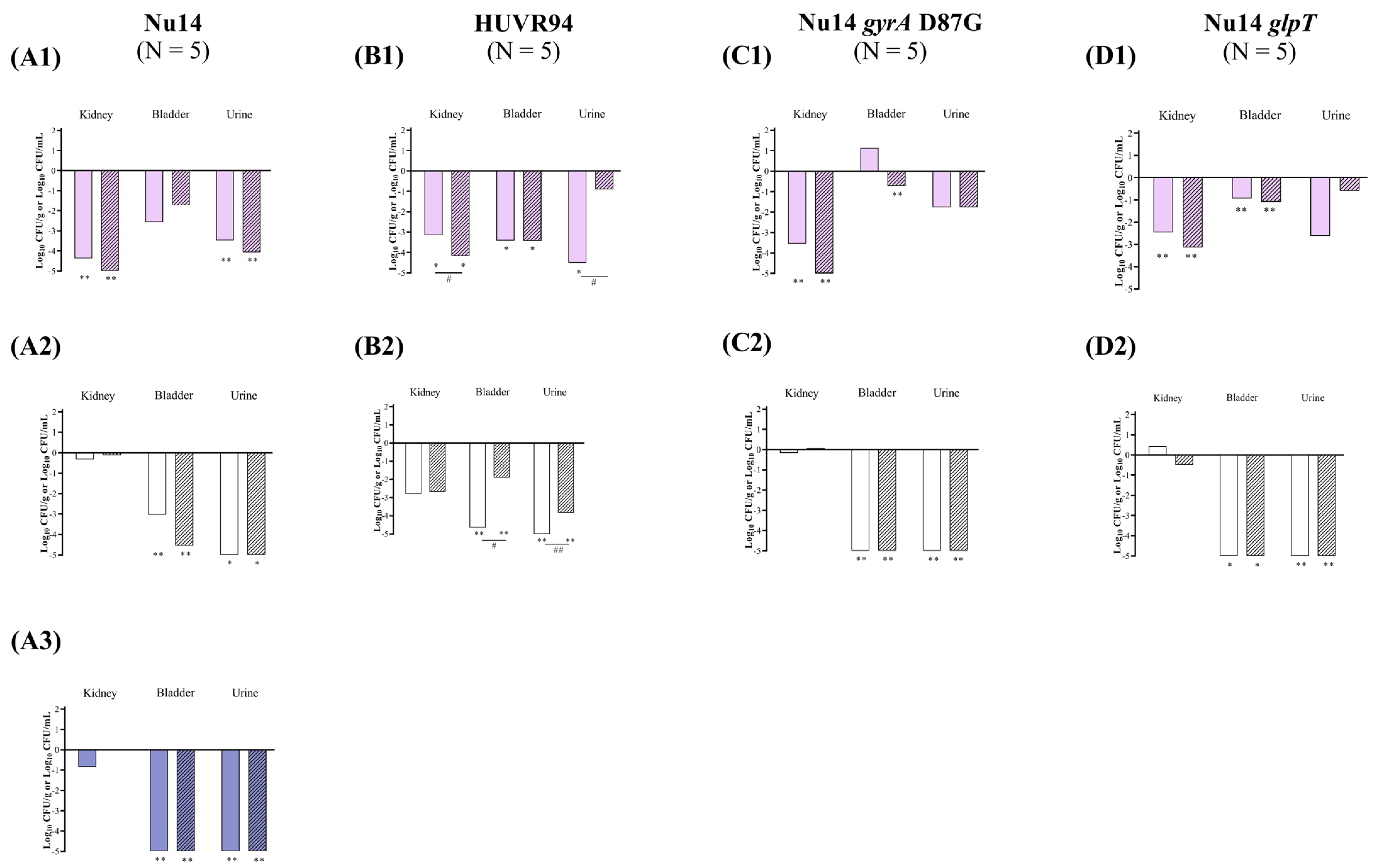
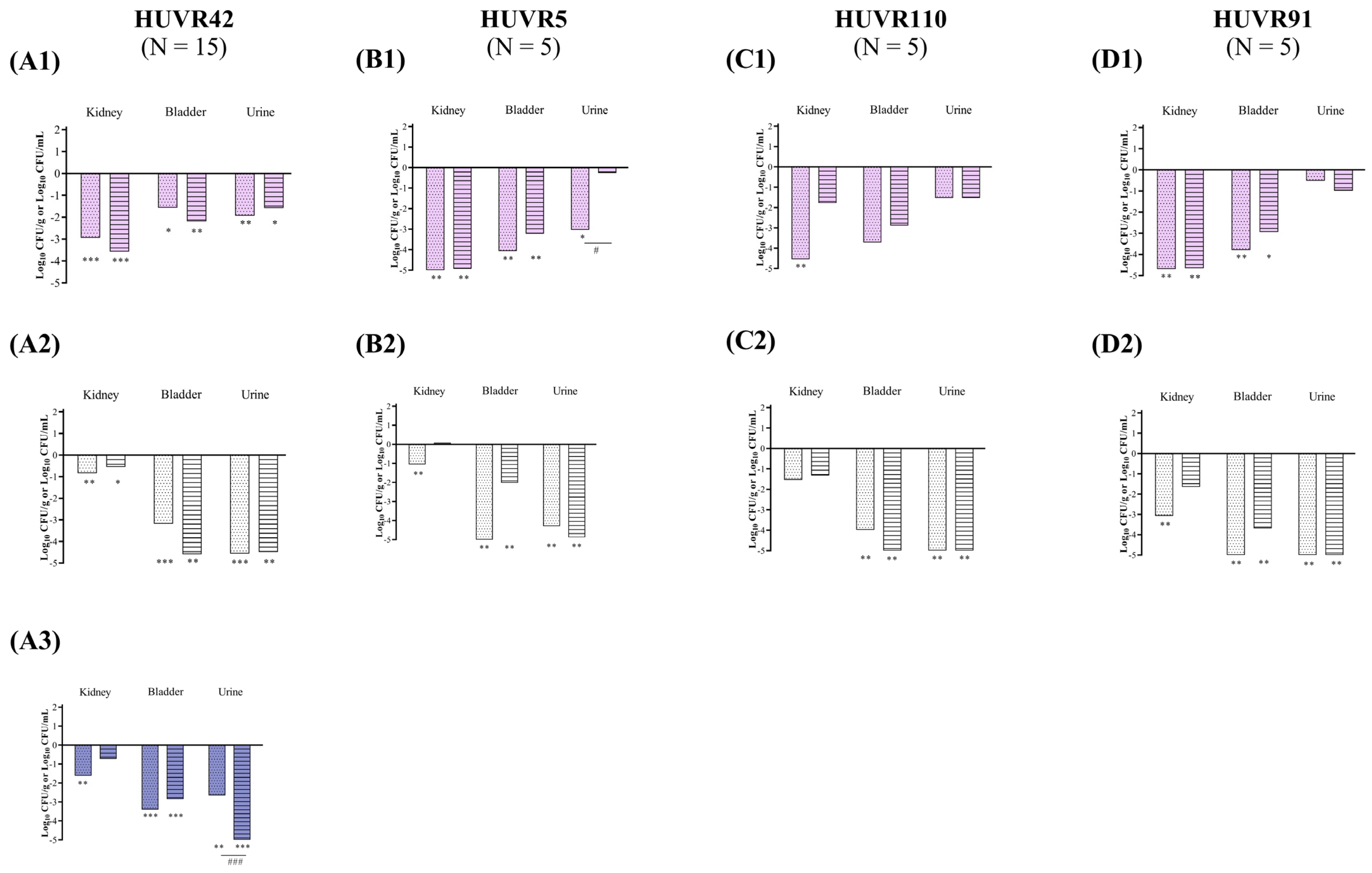
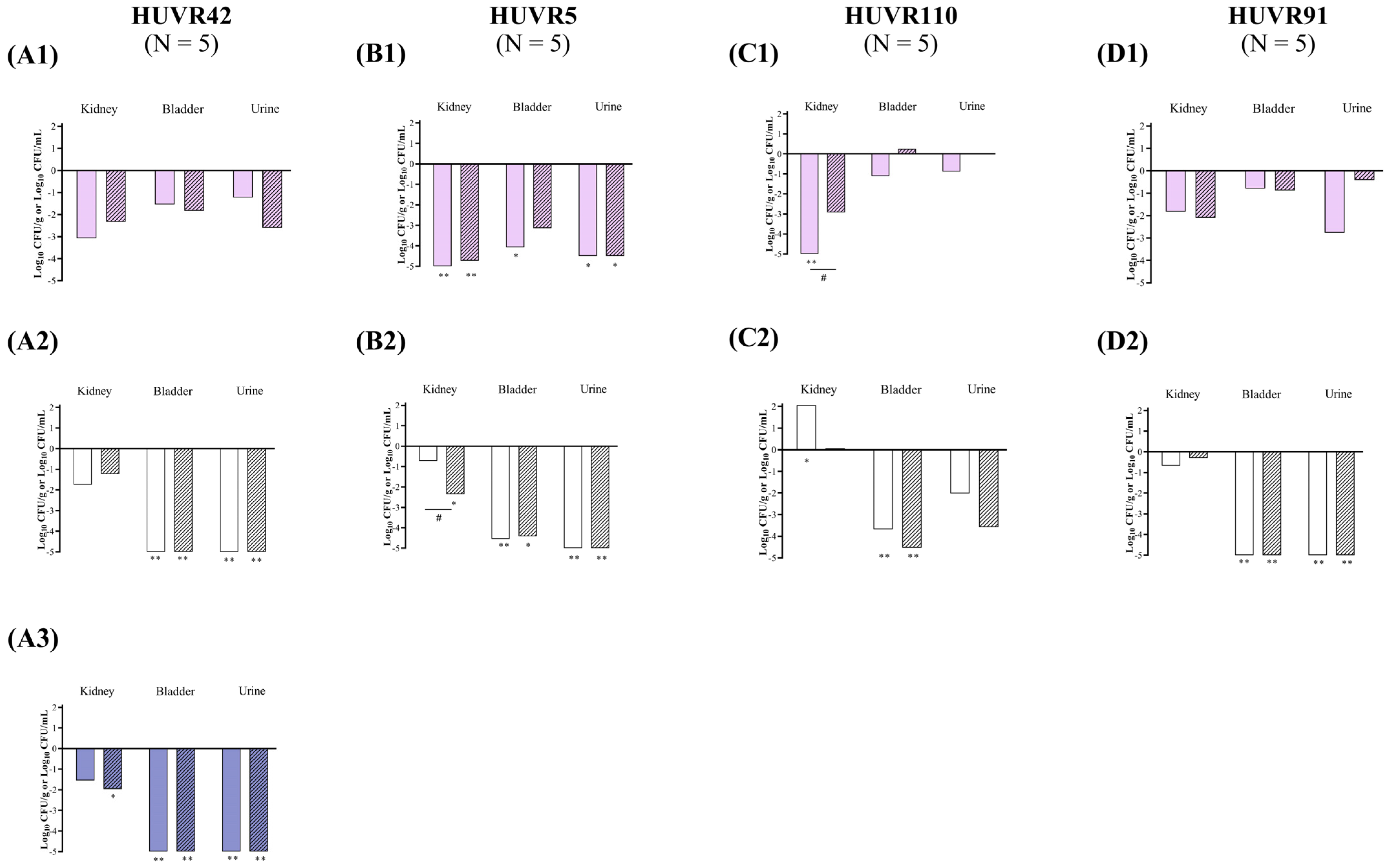
Disclaimer/Publisher’s Note: The statements, opinions and data contained in all publications are solely those of the individual author(s) and contributor(s) and not of MDPI and/or the editor(s). MDPI and/or the editor(s) disclaim responsibility for any injury to people or property resulting from any ideas, methods, instructions or products referred to in the content. |
© 2024 by the authors. Licensee MDPI, Basel, Switzerland. This article is an open access article distributed under the terms and conditions of the Creative Commons Attribution (CC BY) license (https://creativecommons.org/licenses/by/4.0/).
Share and Cite
Herrera-Espejo, S.; Carretero-Ledesma, M.; Bahamonde-García, M.A.; Cordero, E.; Pachón, J.; Pachón-Ibáñez, M.E. Assessing the Influence of Urine pH on the Efficacy of Ciprofloxacin and Fosfomycin in Immunocompetent and Immunocompromised Murine Models of Escherichia coli and Klebsiella pneumoniae Infection in the Lower Urinary Tract. Antibiotics 2024, 13, 827. https://doi.org/10.3390/antibiotics13090827
Herrera-Espejo S, Carretero-Ledesma M, Bahamonde-García MA, Cordero E, Pachón J, Pachón-Ibáñez ME. Assessing the Influence of Urine pH on the Efficacy of Ciprofloxacin and Fosfomycin in Immunocompetent and Immunocompromised Murine Models of Escherichia coli and Klebsiella pneumoniae Infection in the Lower Urinary Tract. Antibiotics. 2024; 13(9):827. https://doi.org/10.3390/antibiotics13090827
Chicago/Turabian StyleHerrera-Espejo, Soraya, Marta Carretero-Ledesma, Manuel Anselmo Bahamonde-García, Elisa Cordero, Jerónimo Pachón, and María Eugenia Pachón-Ibáñez. 2024. "Assessing the Influence of Urine pH on the Efficacy of Ciprofloxacin and Fosfomycin in Immunocompetent and Immunocompromised Murine Models of Escherichia coli and Klebsiella pneumoniae Infection in the Lower Urinary Tract" Antibiotics 13, no. 9: 827. https://doi.org/10.3390/antibiotics13090827





